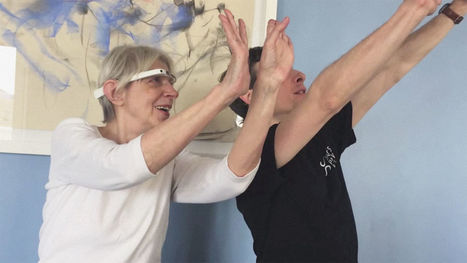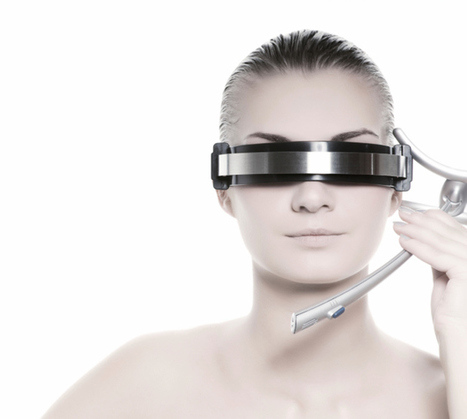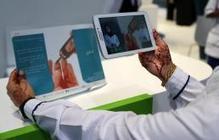According to the National Parkinson Foundation, Parkinson’s disease is the second most common neurodegenerative disease after Alzheimer’s, affecting about 1 million Americans and an estimated 4 million people around the world.
Get Started for FREE
Sign up with Facebook Sign up with X
I don't have a Facebook or a X account


 Your new post is loading... Your new post is loading...
 Your new post is loading... Your new post is loading...
Especially after Facebook’s famous acquisition of Oculus VR, you probably associate virtual reality exclusively with video games. But the technology that creates immersive, three-dimensional virtual environments has huge potential not only for the creation of captivating entertainment experiences, but also for changing how fields like medicine have traditionally worked. From head-mounted displays to five-walled environments, and from computer-based solutions to Google Glass, here are five different experiments that have demonstrated how virtual and augmented reality are already changing the way that diseases and chronic conditions are diagnosed and treated.
Mirko Compagno's insight:
1. Virtual reality can help diagnose cognitive decline
A new research project at the University of California’s Qualcomm Institute called the VE-HuNT System (Virtual Environment Human Navigation Task) looks to use virtual reality to aid the diagnosis and treatment of memory failure and diseases like dementia. The system is a research project of Eduardo Macagno, a biological sciences professor at the University of California San Diego.
2. Virtually reality improves social cognition in young adults with high-functioning autism
Several studies have used virtual reality as a therapy method for both children and adults with autism spectrum disorders. One study, by Michelle R. Kandalaft, Nyaz Didehbani, Daniel C. Krawczyk, Tandra T. Allen, and Sandra B. Chapman, all researchers at the University of Texas Dallas, focused on using virtual reality social cognition training to help eight young adults with high-functioning autism enhance their social skills, social cognition, and social functioning.
Research at the University of Southern California’s Institute for Creative Technologies uses virtual reality exposure therapy to relieve post-traumatic stress. The therapy system, called Bravemind, is based on the concept of exposure therapy, in which a patient confronts and processes his or her trauma memories by retelling the experience to a therapist. Traditional methods of exposure therapy have been endorsed as an effective treatment for post-traumatic stress. The ICT’s Bravemind system takes exposure therapy a step further by leveraging virtual reality to enable patients to experience a scenario again instead of simply relying on their memory as they recount an experience.
Researcher Max Ortiz Catalan, a doctoral student in biomedical engineering at Chalmers University of Technology in Sweden, and colleagues Nichlas Sander, Morten B. Kristoffersen, Bo Hakansson, and Rickard Branemark developed an augmented reality therapy to relieve an amputee’s phantom limb pain. Phantom limb pain is traditionally treated with a variety of different methods, among them mirror therapy. Mirror therapy uses an actual mirror to train the body to reconfigure its mental representation or where each limb of the body is. The body often misrepresents where a limb is when severe injury or the loss of a limb occurs, and experts think these misrepresentations cause pain in “phantom limbs” that are no longer there. The brain remembers the pain in a limb before it was removed, and continues sending the same nerve signals because it thinks that the limb is still there. In mirror therapy, the patients moves both limbs — the one that is still intact and the phantom limb — in coordination to correct the body’s misrepresentations of the limb and pain.
As VentureBeat reported in March, Stanford physician Homero Rivas has experimented with a Google Glass app called MedicAR, developed by Droiders, a European team of mobile developers who specialize in “Glassware,” or apps for Google Glass. The partnership between Rivas, who is Stanford’s director of innovative surgery, and Droiders came out of the interest in wearable tech that Rivas shares with Julian Beltran, Droiders’ chief executive. |
HE Eng. Essa Al Maidoor, Director-General of the Dubai Health Authority , said: "It is important to keep up with changing times and adapt latest technologies across all fields of health care including community health education so as to enhance customer experience.
Mirko Compagno's insight:
Today, with the smart technology revolution, people can access information on their fingertips, at a time convenient to them.
Augmented technology fundamentally changes the way we interact with things and objects on a daily basis and in terms of print, it brings it to life. It is highly interactive, has features such as live characters that pop-up on screen, audio features among many others that significantly enhance user experience."
Dr Manal Taryam, CEO of Primary Health Care at the DHA, said: " This is the latest technology in health education and an extremely interactive way of raising health awareness. People of all ages, particularly the youth, will appreciate this technology. As we move towards smart health, we envision further developing this field to reach out to all sections of the community."
The DHA brochures are available across all 14 primary healthcare centres and at the DHA's stand at GITEX 2014. People can download the brochures which will contain information about prevention, early detection and treatment of various diseases. |











In 2002, New York-based Mark Morris Dance Group (MMDG) launched its Dance for Parkinson’s Disease program, based on the concept that the movement and training used by professional dancers to build balance, power and coordination could also help Parkinson’s sufferers.
Last year, seeing the potential of wearable technology, program director David Leventhal applied for and was awarded one of Google's five Explorer grants for non-profit organizations to develop applications for the Glass platform.
The group teamed up with ad agency ad SS+K to help design, develop, and launch Moving Through Glass, an augmented reality app created to provide 24/7 aid for people with Parkinson's that's now available to the public.
Kevin Skobac, SVP, digital strategy and innovation at SS+K says people living with Parkinson's were invited to review and test the project at various development stages, while researchers from New York Presbyterian/Weill-Cornell Medical Center, and Stanford University's Movement Disorders Center are advising on, and testing the app.
Parkinson’s Disease is a movement disorder affecting nerve cells and one of the most common symptoms is having difficulty initiating movement. The app features warm-up routines to get people get moving.
A walking guide uses video and music to set a pace, to help with the tremors and jerky movements common with Parkinson’s that can make walking difficult. Parkinson’s sufferers can also become "stuck" in the middle of a movement and have difficulty re-initiating movement, so the app provides standing routines that gradually get users out of a freeze and back to walking.